
8 minute read
A partnership with the Ritsumeikan University in Kyoto
Professor

Advertisement
by Mia Marchini Technical and scientific coordinator of Professional Pasta

The international conference “From Seed to Pasta IV” held in November 2022 provided a fundamental update on the state of the art of global scientific research on durum wheat that is oriented towards a more sustainable and resilient pasta supply chain that can improve food safety, nutrition and consumer health. The participation of the editorial staff of Pasta&Pastai and Professional Pasta in the conference led to a request for collaboration with the College of Gastronomy Management of the Ritsumeikan University of Kyoto, by Professor Masayoshi Ishida, former president of Slow Food Japan and one of the leading scholars of Italian food and wine in Japan. Inspired by the principles of the international Slow Food association and the mission of the University of Gastronomic Sciences in Pollenzo, with which it has signed a collaboration agreement, the Ritsumeikan University is the first Japanese university specifically focused on the in-depth study of international gastronomy knowledge. Professor Ishida and his research group recently coordinated a study in collaboration with Pasta Cuomo to deepen the knowledge of Gragnano pasta. Therefore, the interest in pasta as Italian excellence in the world has led to an in-depth historical, cultural, enogastronomic and etymological study of the types of pasta on the Japanese market. The investigation, which is part of a broader study aimed at understanding the process of diffusion, transformation and affirmation of Italian food and wine in the world, is supported by the Iijima Tojuro Foundation, whose founder is Yamazaki Pan, one of Japan's largest bread producers. Italian food and wine - and pasta in particular - began to spread in Japan as early as the Meiji period (1868-1912) and became increasingly rooted in Japanese food culture, undergoing unique transformations. The aim of the research is to unify the names of the various noodle formats in Japan, to communicate the official names on a digital platform that also provides historical and cultural concepts as well as dishes that have spread throughout the country, making them available and searchable worldwide. To this end, preliminary research was carried out in 2021 to create a database of the pasta formats widespread in Japan and an analysis of the recipes that can be found in this country. The editorial staff enthusiastically accepted the proposal and took action by involving Andrea Maraschi, Professor at the University of Bari and expert in food history as well as Giancarlo Gonizzi, curator of Academia Barilla's Gastronomic Library, coordinator of Food Museums in the Province of Parma and member of the Toponomastic Committee of the Municipality of Parma since 2003. There are many stories about the origins of pasta and similar products made over time. From the Etruscan “mixture”, to the Neapolitan “Macaria” (a pasta made from sun-dried barley flour and water); from Cicero’s passion for “laganas”, to the city of Palermo, considered as the first real capital of pasta. Moreover, the earliest historical evidence of artisanal and industrial pasta production (9 th century) is Sicilian: Ibran ‘al Mibrad’s recipe book describes different shapes and types of pasta or in the “Il libro di Ruggero”, a text composed around 1154 by the Arab geographer Al-Idrisi, we read that 30 kilometers from Palermo, “so much pasta in the form of threads was being made that it was exported everywhere”. What is certain is that, over the course of time, pasta has continued to be served on Italian tables, although under different names. If in the 15 th century it was called “lasagne” with reference to the term “lasagnare” relating to pasta-making, in the 19 th century the name changed to “vermicelli”, from “vermicellai”. And again, “fideli” (cylindrical threads of pasta), with pasta makers becoming “Fiderari”. Unfortunately, the interest in the facts of everyday life and the linguistic repercussions related to the history of food and nutrition has not had much success in Italy. Similarly, the first “Etymological Vocabulary of Italian Pasta” by Franco Mosino, an Italian philologist, Greek scholar and intellectual, was compiled in 2011, offering a research tool on the history of food that is more exquisitely Italian. References to the linguistic field appear in the vocabulary, which makes this writing unique. The extraordinary variety and widespread diversity of names given to pasta in Italy is certainly striking. For instance, we learn the etymology of the name “tagliatelle”, from the verb “tagliare” (“to cut”). The Bolognese Augusto Majani, better known by his pseudonym Nasica, designer and writer, in order to engage in violent polemics against Marinetti, a systematic enemy of dry pasta, invented a fictitious commemoration of the birth of tagliatelle, created by Mastro Zefirino, a famous medieval cook. This storytelling was accepted by many, also because it was a quite likely reconstruction... Tagliatelle belong not only to the Christians, but also to the Jews. This is their recipe for making noodles: “He put a little flour on the table and added twelve eggs and twelve egg-measures of water. Start
kneading” (E. Loewenthal).
“Trenette”, instead, are typical of Genoa. It is a kind of flattened spaghettis with a lenticular section, usually combined with a basil pesto sauce. Their name comes from the Genoese word “trena” that means “string”, which has also migrated into northern dialects as “tarnèti”. The term “ravioli” possibly derives from the Genoese word “ravièu” that means “blackbird”. According to another etymology, the word “ravioli” comes from the medieval Latin “rabiola” which means “small turnip”; it is mentioned in a letter of archbishop Giraldo, at Matteo Parigino, with the meaning of “manicaretto” which means “delicacy”. According to a third hypothesis, the word would instead be a variant of “robiola”, northern Italian for “goat’s cheese”. Until the late 19 th century, the Ligurians considered ravioli as a festive food for New Year’s Eve and Carnival. The latter is recalled by a Genoese proverb: “ L'urtimo giorno da Carlevà / de ravieu se ne fa unna pansà ” (the last day of Carnival is a feast of ravioli). In Lombardy, two idioms were used until the early 20 th century: “ Andà in fumm de ravioeu ” (it went up in ravioli smoke, said of a thing or project, which vanishes) and “ Battezzàa con l’acqua di ravioeu ” (baptized with the water of ravioli, said of a foolish person).
It is precisely because of this extraordinary linguistic variety, that is impossible to codify completely, that we will support Professor Masayoshi Ishida, who has set himself a goal that is equally virtuous and hard in trying to understand and interpret the etymology of the different shapes of an all-Italian excellence.
Mia Marchini
Smart labels: La Molisana applies the Qr Code

Supermarkets receive smart labels and products that tell their story. La Molisana, one of the Italian historic pasta factories founded in 1911, broke the silence between producers and consumers. The company, based in Campobasso, has recently arrived in the large-scale retail trade with new packs of pasta with a new claim, “Parola alla pasta” (Let pasta speak) associated with a Qr code which can be framed with a mobile phone camera to enter La Molisana world. Hundreds of recipes within everyone's reach and the story of the 100% Italian supply chain leading from the field to the packs of pasta, passing through an entirely internal production process.

Andriani plans to open production facility in London, Ontario
London’s food production scene continues to grow, with Italian food processor Andriani announcing on Wednesday that it is opening its first-ever North American allergen and gluten-free pasta production facility in London. According to a press release, Italian food processor Andriani S.p.A. has chosen the Forest City for its first North American production facility. The new 50,000 sq. ft. allergen and gluten-free pasta manufacturing facility will be located on five acres of land in London’s Innovation Park, located at Bradley Avenue and Veterans Memorial Parkway. The new facility will employ 50 people in the initial phase and procure raw materials from southwestern Ontario.
Two Hard-to-Find Italian Pasta Shapes Are Hitting Shelves in the US
Pasta manufacturer Sfoglini is teaming up with The Sporkful Podcast creator and host Dan Pashman to add three likely-new-to-you pasta shapes to your pantry. The two existing shapes hitting the brand’s roster are quattrotini and vesuvio, fun to look at, fun to wrangle on your fork, and fun to eat. The third is a new shape designed by Pashman himself, called cascatelli. We say “likely-new-to-you” because two of the shapes can be found in small regions around Italy. You may have heard of quattrotini, a pasta shape that is served once a year during Carnival in a small region of Sicily. The original shape - four tubes connected by a four-sided rectangle - was slightly tweaked to include ridges, making it easier to grab sauce. The second shape, vesuvio, was named for its likeness to Mount Vesuvius. Short, round, and anchored by a large base that tapers to a thin cone, sauce collects into the spirals promising a perfect bite every time.
Pasta Market Size Will Surpass $64.25 Billion at 7.3% CAGR Growth

According to a report published by Vantage Market Research, Pasta industry is projected to reach Usd 64.25 billion by 2028 at a CAGR of 7.3% over the forecast period. Dry pasta and super and hypermarket account for the largest market share in the upcoming future. The dried form is preferred to the chilled or canned form because it comes in a wide variety of sizes and can be easily stored. The supermarket/hypermarket segment is estimated to account for the largest share of revenue, as consumers have the option of properly checking nutritional features and making informed purchase decisions. Pasta is a staple food in many cultures and is popular for its convenience, versatility, and affordability. The market is driven by various factors such as rising demand for ready-to-eat meals, increasing popularity of Italian cuisine, and the growing trend of plant-based diets.

Pasta Almost Too Pretty to Eat
David Rivillo’s rainbow ravioli is equal parts art and science. The 45-yearold Venezuelan, who is now based in Porto Alegre, Brazil, started making colorful patterned pasta in 2019 in tribute to his favorite artist, Carlos Cruz-Diez, a Venezuelan known for his chromatic relief murals who died that year at the age of 95. Putting his Ph.D. in chemistry to good use, Rivillo experimented with natural dyes (such as spirulina and paprika) to find those that would maintain their hue even when dried or cooked and posted his work on Instagram. Now, Rivillo, who recently left his job as a nanotechnology researcher to pursue the project full time, sells his creations (from $40 for 2.1 ounces, plus shipping).

Pasta championship kicks off in France

Seggiano triumphs with triple win at Best Brand awards
The Association of French Pizzerias has decided to create a professional event around pasta, an unmissable dish of Italian gastronomy. This competition will be the opportunity to promote the know-how and enhance this much-loved product. The championship, which will be called “France Pasta”, will comprise twenty restaurant owners and each of them will compete in different tests to win over the jury. For the first test, three Italian regions will be highlighted through three pasta categories: Orecchiette for Apulia, Trofie for Liguria and Casarecce for Sicily. The Association's website specifies that “candidates will have to create a dish based on the typical Italian recipes of each region”.
Seggiano, an ethically sourced Italian food specialist that offers best-in-category larder essentials, has come out on top in Fine Food Digest’s Best Brands survey 2022/23, placing first in three categories; pasta, sauces, and oils and vinegars. The survey identifies the mostloved and best selling products at independent retailers across the Uk’s fine food and drinks sector, by asking buyers across the country in delis, farm shops and food halls, to name their top-selling brands. The 11th annual survey had over a dozen categories and the results were published in January 2023. Winning first place in pasta, sauces and oils and vinegars, Seggiano prides itself on being ethically sourced and Gmo-free, with each product being individually derived from specialist and innovative Italian producers.

Pasta with 20% cricket flour
The Thai company Bugsolutely produces a pasta with 20% cricket flour to increase its protein boost. The product is called Bugsolutely Cricket Pasta and is advertised as something completely new: a sustainable superfood containing 20% cricket flour. The company presents its product as a true “Superfood” suitable for: Chefs for new presentation products, Body Builders, because it contains 65% protein and distributors because this is the mega trend of the future. Yet, why increase the amount of protein in pasta? A low-protein pasta requires a slow, more gentle drying process, conversely one with a high-protein content can be dried quickly.










